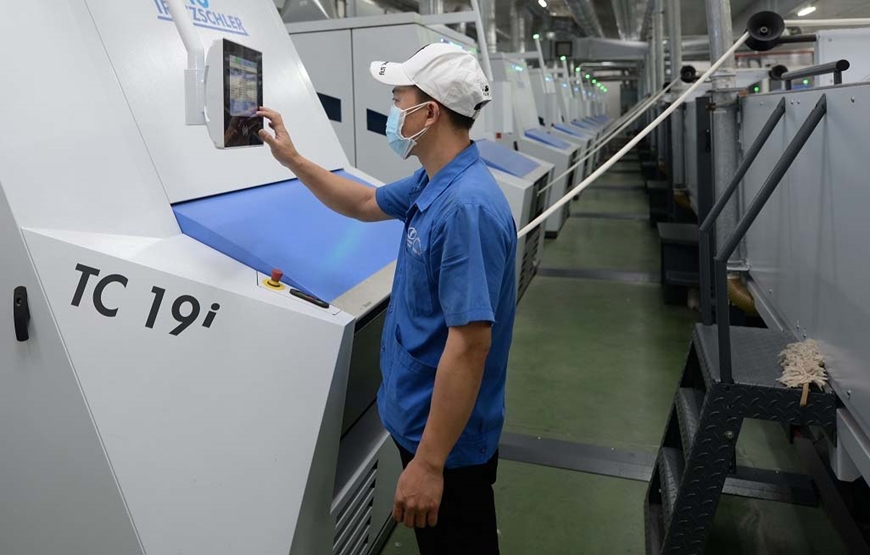However, talking to reporters, Mr. Vu Duc Giang, Chairman of the Vietnam Textile and Apparel Association, said that in the last 6 months of the year, the textile and garment industry will face many new difficulties, especially fluctuations from the market. . However, the textile and garment industry is still determined to reach the export target of 43 billion USD for the whole year.
Trade surplus of USD 8.86 billion in 6 months

Mr. Vu Duc Giang.
Reporter (PV): The first half of 2022 figures for the textile and garment industry show optimism. What do you think about the above results?
Mr. Vu Duc Giang: In the first 6 months of this year, textile and garment exports have experienced quite different levels. In the first 3 months of the year, export prospects are very positive; In the next 2 months, the situation was still relatively good, but in June, difficulties began to appear when the global demand for textiles and garments decreased. Specifically, in the first half of 2022, the US, the European Union (EU), Japan, Korea, and China are the top 5 export markets of Vietnam's textile and garment; in which the US is the largest export market, accounting for 40% of the market share. US economy declines, large inventories; The purchasing power of the EU and Japanese markets also decreased, greatly affecting Vietnam's textile and garment exports in the end of the second quarter and the beginning of the third quarter. One issue worth noting is that the EU market has introduced a policy to use recycled products. Another notable factor is that the price of raw materials, fuel and auxiliary materials is constantly increasing, making the cost of textile enterprises increase by about 20-25%.
As a result, in the first half of the year, textile and garment export turnover is estimated at about US$22.3 billion, up 17.7% over the same period in 2021. The main export items are garments, fabrics, and fibers. , textile accessories, non-woven fabrics. Meanwhile, the total import turnover of textile and garment materials and accessories in the first 6 months of 2022 is estimated at 13.4 billion USD, up 9.8% over the same period in 2021. With the above results, the whole textile and garment industry trade surplus of 8.86 billion USD in the first half of this year, up 32% over the same period last year. In the context of the world economy still facing many difficulties, this is a great effort of Vietnamese textile and garment enterprises.

Produced at Yen My Yarn Factory, 8-3 Textile One Member Limited Liability Company in Hung Yen province. Photo: QUANG NAM
Reporter: In addition to the production and business results, over the past time, the technological innovation and greening of the textile and garment industry have achieved initial results. So where is the textile industry in this process, sir?
Mr. Vu Duc Giang: Greening the textile industry is a global trend, forcing businesses to implement it to achieve sustainable development goals and increase exports to major markets that have signed free trade agreements. Well aware of this problem, the green program of Vietnam's textile and garment industry is also being promoted by enterprises. Enterprises invest in infrastructure to meet the standards required by customers; create a green working environment; investing in using renewable energy sources... Enterprises also focus on applying automation and digital management solutions. This is an inevitable trend, creating a difference and a very good foundation for quick adaptation, meeting market requirements, and ensuring the industry's sustainable development goals. As in the yarn sector, there has been a factory that has invested in full automation from the beginning to the end; In the sewing process, many enterprises apply automation in many stages, a worker can stand 3-4 machines; In digital management, about 60% of enterprises in the industry have been interested in investing.
Challenges from the demand reduction market
Reporter: In 2022, the whole Vietnamese textile and garment industry aims to reach 43 billion USD. Thus, the task of the last 6 months of the year is still very challenging, sir?
Mr. Vu Duc Giang: This is quite a heavy task. As mentioned above, global demand for textiles and garments has shown signs of decline, especially in major markets such as the US and EU. Surveys and evaluations of sellers and international organizations show that, in the US market, high inflation causes people to significantly limit spending, in which apparel is the item that has been cut the most spending. . In particular, the depreciation of the euro will make commodity prices go up. In the context that EU people are tightening their spending, it has made it difficult for countries that export textiles and garments to this market, not only for Vietnam's textile industry.
In addition, the risk of a re-epidemic outbreak still exists. Many markets that are important trading partners of Vietnam such as China, Japan, Taiwan (China)... are still applying strict anti-epidemic measures, significantly affecting the raw material supply chain. , materials and consumption of textile products of Vietnam. Along with that, the labor shortage after the pandemic, the requirement for traceability of cotton, fabric, yarn or the greening of textiles from new-generation free trade agreements are also challenges that Vietnamese textile and garment enterprises face. South is facing.
Reporter: The goal is very big, what are the recommendations for textile enterprises, sir?
Mr. Vu Duc Giang: In order to stabilize production, towards sustainable goals in the coming time, enterprises need to catch up with market trends, continue to invest in changing technological equipment to adapt to the requirements from importing countries, typically the requirement for recycled garments entering the EU market today. In particular, strengthening solutions to build and train human resources to adapt to the difficult situation of the market, especially focusing on design human resources for the fashion industry. Enterprises also need to expand more markets so as not to be too dependent on a few export markets, prone to risks and disruptions when the world situation is volatile and the Covid-19 epidemic is still dangerous and unpredictable. . For example, in the first 6 months of the year, in addition to the 5 traditional markets, enterprises have begun to switch to exploiting the Middle East and African markets, this makes an important contribution to textile enterprises to overcome difficulties.
PV: Thank you very much!
KHANH AN (thuc hien)
https://www.qdnd.vn/kinh-te/cac-van-de/det-may-quyet-tam-huong-toi-muc-tieu-xuat-khau-43-ty-usd-701530
qdnd